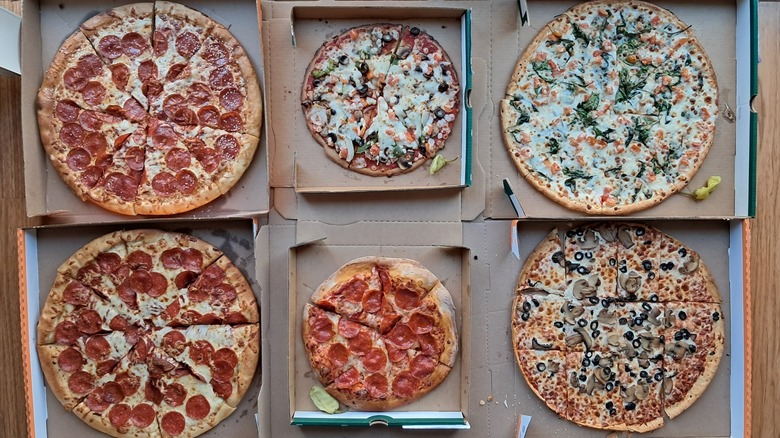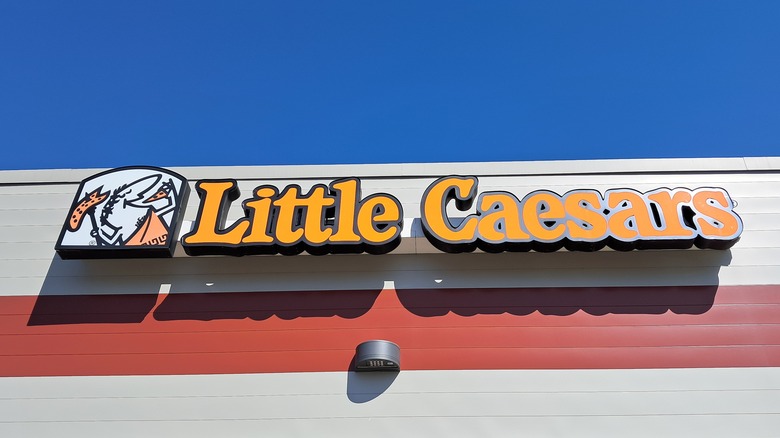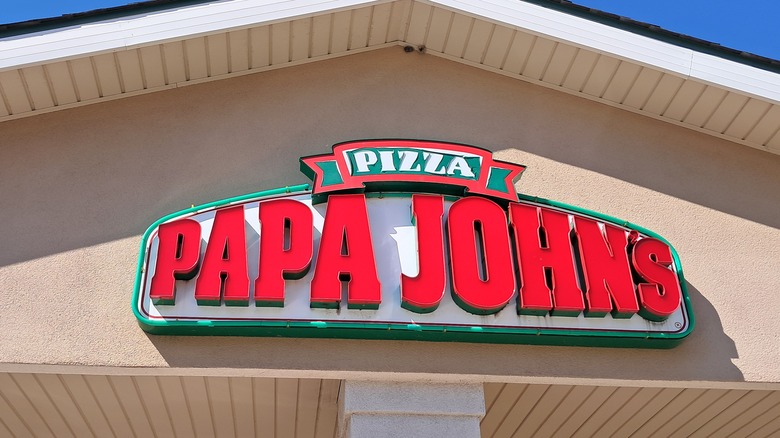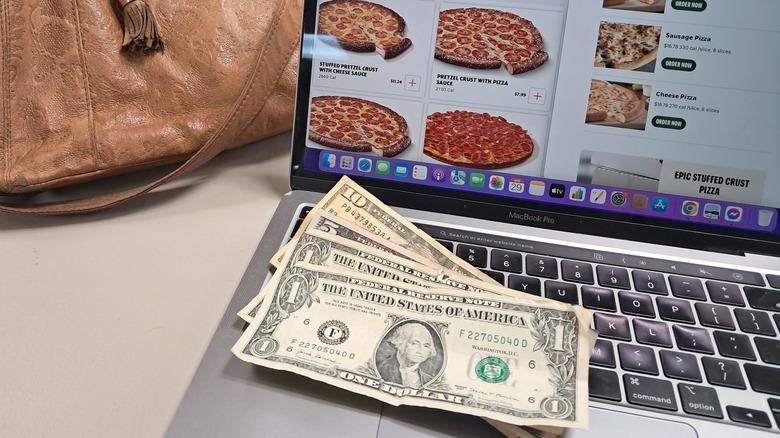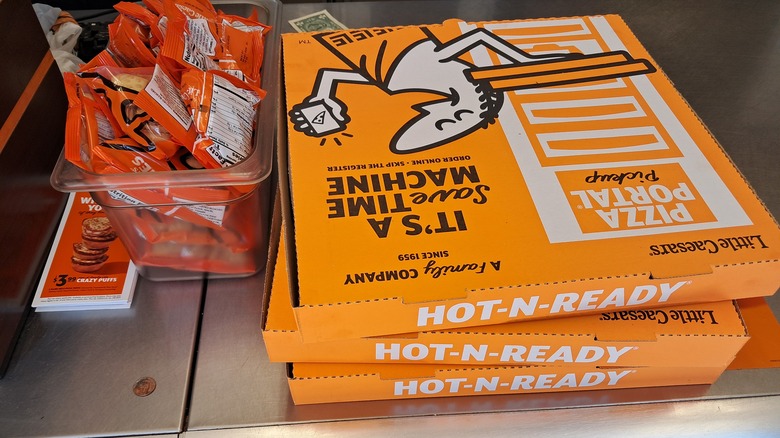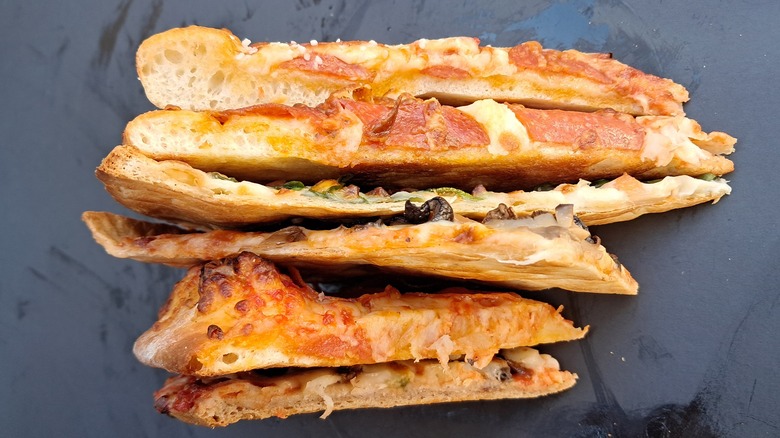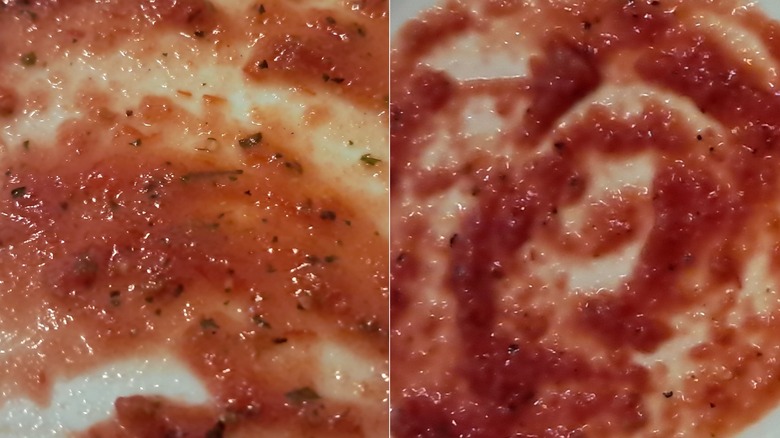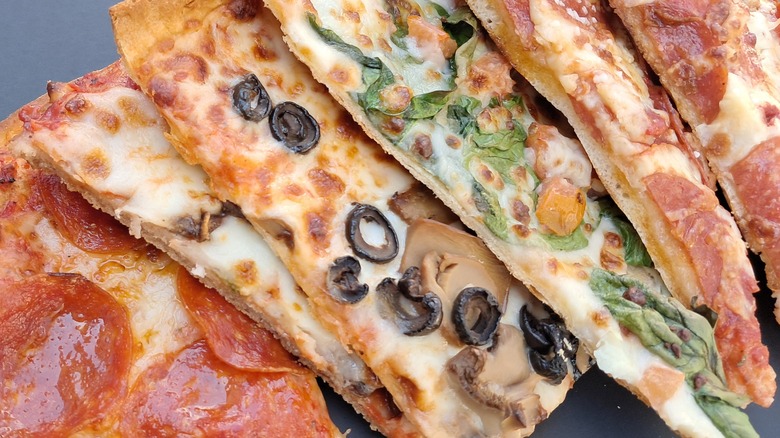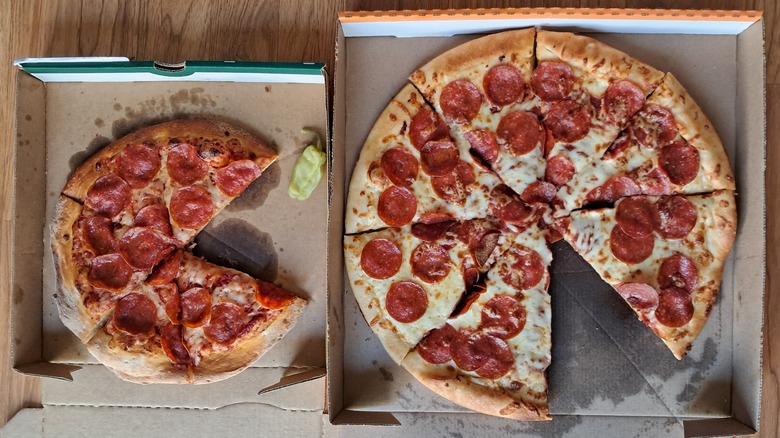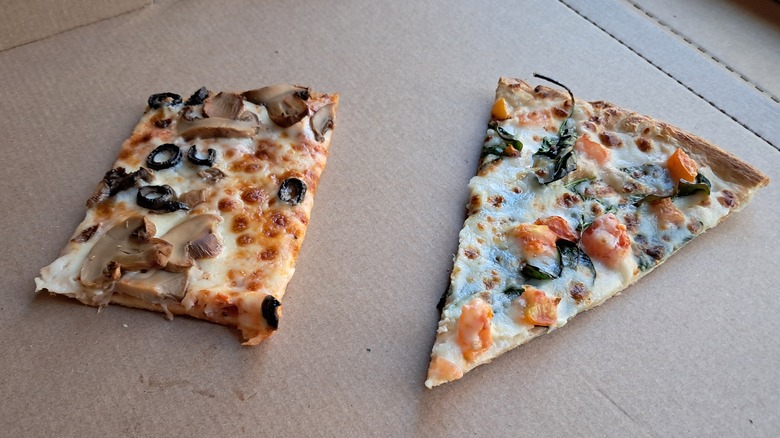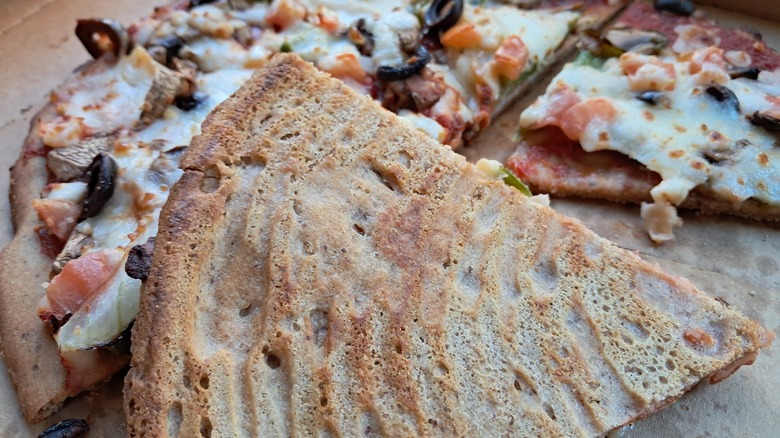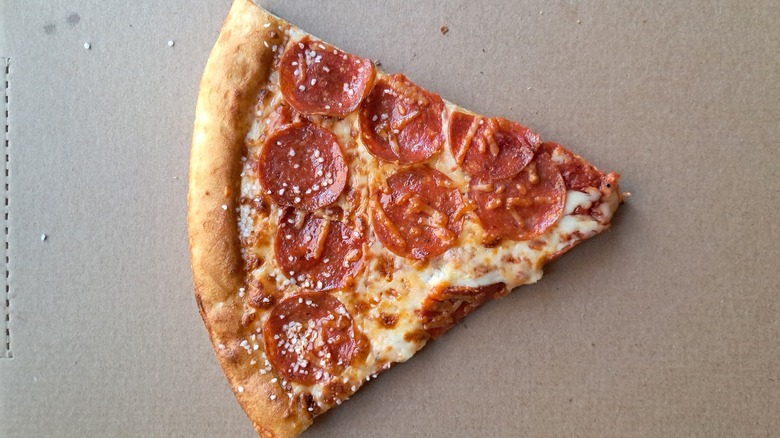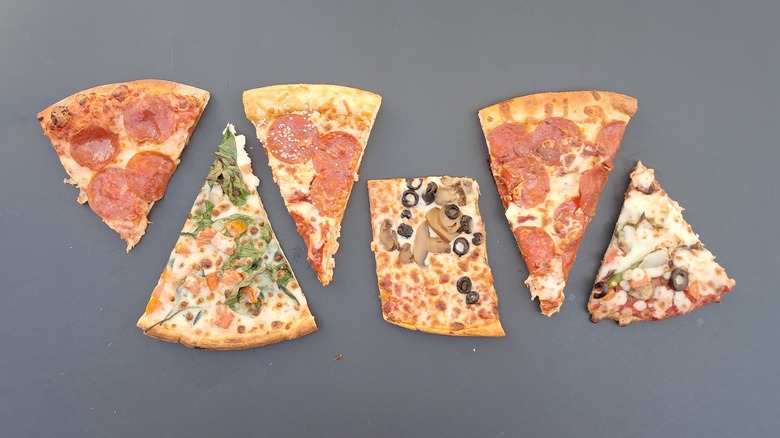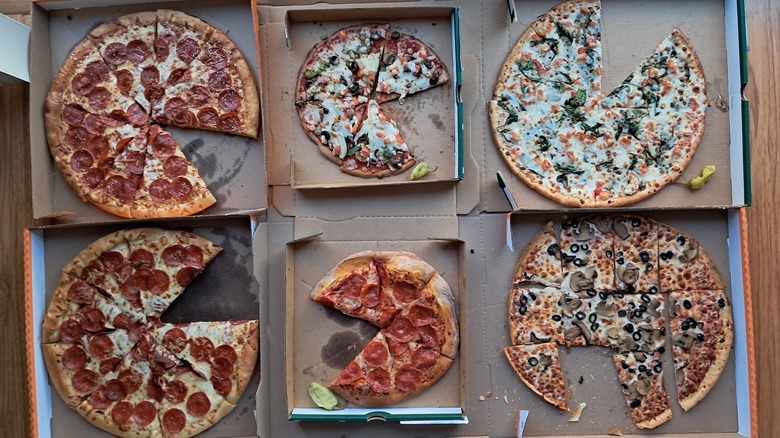Little Caesars Vs Papa John's: Which Pizza Is Better?
You're hosting a slumber party for noisy fifth graders and you want to know what you should order for dinner: Papa Johns or Little Caesars. The kids are begging for greasy pepperoni, but the adults want something a little more complex with a bit of green on top. Worse, you're pressed for time — everyone's hungry now, and if you don't feed them immediately, the entire event could turn into a grump city. You've got both apps on your phone and your thumb hovers over one, then the other. This isn't an easy decision to make.
Have no fear — I'm here to help. I've taken a close look at both carry-out pizza chains to see which is most convenient for this exact situation (and, in a similar fashion, if you're interested in Little Ceasers versus Pizza Hut, we've got that covered, too). I've analyzed which company offers the lowest price and has the quickest prep times. Not only that, I've compared the crusts, toppings, and sauces on the menus. If you want to know more about how I did this, check out the description of the methodology at the end of this article. Additionally, the prices and menus mentioned here are accurate for the time and place I visited Papa Johns and Little Caesars. They may change over time or by region, so if you want exact information about your local franchises, ask before calling in an order.
Little Caesars advertises lower prices and more convenient pizza
Little Caesars has a reputation for low prices, extra grease, and convenience. The first restaurant opened in a Detroit suburb in 1959 and, from early on, the pizzeria emphasized giving patrons a good deal on its pies. The famous "Pizza, pizza" slogan advertised that you could buy two there for the price of one elsewhere. Then, in the late '90s, Little Caesars drew customers in with the promise of convenience as well as cheap pizza. More than 20 years later, the Hot-N-Ready campaign still claims anyone can walk into a franchise and ask for pizza or breadsticks from the warmer at any time. The cashier will hand over the food with no wait and no worry about ordering 20 minutes ahead of time.
You probably want to know if the alluring prices and convenience are real. After all, reputations do not always translate into truth. Then, if everything is as good as the advertising says, you can buy two Hot-N-Ready pizzas from Little Caesars for the price of one at Papa Johns, you might doubt the quality of the product. Logic would dictate the company must cut corners somewhere to offer up pizza so quickly at such a low price. I set out to test the convenience and price by visiting our local Little Caesars, and then eating a few slices to see for myself if the quality, taste, or texture had suffered.
Papa Johns claims its ingredients and pizza are better
The Papa Johns slogan used to be, "Better ingredients, better pizza," but now the chain has added a third phrase, "Better get you some" in a new font with new colors. The publicly traded company is still rebranding itself to create distance from founder John Schnatter who was slammed after using a racial slur. Note the lack of an apostrophe on the signs — the corporation wants you to know it's no longer "John's" pizza you're buying. It's ironic the company would remove the punctuation, but not the name to achieve that.
The disagreeable things Mr. Schnatter said likely won't have an impact on the quality or price of the pizza more than five years after he resigned, though. The first part of the slogan, which rolled out in the '90s and caused a legal battle with Pizza Hut, promises something concrete: The quality of the ingredients at Papa Johns is better, and that gives consumers a better pizza. Since it doesn't mention price or convenience, you might assume pizza at this chain takes longer to prepare and costs more in the name of better taste and texture. A quick visit to the local franchise tested these theories and gave me the chance to try some of those allegedly better ingredients.
Little Caesars has lower prices than Papa Johns
Little Caesars pizza is significantly cheaper than Papa Johns — if you make the right order. So if you're worried about feeding a bunch of kids at a sleepover, you'll get more bang for your buck at the emperor's pizza shop. Consider this: I purchased six pizzas to taste test for this article. Three large ones from Little Caesars cost under $32, while two smalls and a large from Papa Johns had a price of around $45. It costs a lot more for a lot less food at the second pizzeria. Then, a large pepperoni pizza from Little Caesars costs just under $7, while the same product at the other chain goes for about $17. That more than justifies the "Pizza, pizza!" two-for-the-price-of-one slogan.
Custom pizzas tell the same story. A large pizza, regular crust with three toppings from Little Caesars costs about $13.50, while a similar meal from Papa Johns goes for over $20. One way to get a deal at the second pizza chain was to order two large, two-topping pizzas for $24. Even so, a large two-topping from Little Caesars costs under $11. Papa Johns got close with that deal, but couldn't beat Little Caesars, since the price there was still a dollar less.
Its just as easy to order at Papa Johns as it is at Little Caesar
Despite Little Caesars's claim that its locations are "Save time machines," it's not that much faster to buy pizza there than at Papa Johns. Call in an order, and either place prepares it in under 20 minutes. Yes, the Hot-N-Ready setups allow customers to walk in and buy pizza on the spot, but there are a few caveats. First, what you can purchase depends on what they have available. So, if you need to feed kiddos at a pajama party, you'd be better off calling in your order ahead, because other customers might have already emptied the Hot-N-Ready station. Then, if you want a special kind of crust or more interesting toppings than pepperoni, you'll find the website the easiest way to do that.
The lines at each pizzeria are something you might want to consider, as well. Because you have to order ahead at Papa Johns, the cashier is able to turn over your pizzas much more quickly since, at the most, all they have to do is ring you up. There are rarely other customers in line there. Walking into a Little Caesars is a different experience. Since it welcomes walk-ins, there's often a longer line, and patrons may have to negotiate longer with the customer service rep.
There are six types of crust at both pizza chains
Pizza starts with the crust. It should allow other ingredients to shine but never overpower cheese, sauce, or toppings. Because pizza-eaters look for vastly different qualities in crust — thin and floppy, thick and greasy, chewy, crispy — chains offer variety. Little Caesars and Papa Johns each have six styles. Both have regular, thin, and stuffed crusts. Only Little Caesars lets you add pepperoni inside stuffed, while the other chain offers garlic. Thin and floppy New York style is on the menu at Papa Johns while thick and greasy Detroit style appears at the competition. Little Caesars stands out with pretzel crust while Papa Johns allures a new demographic with a gluten-free crust.
The taste depends on the variety. Papa Johns's regular (fifth down in the photo) was chewier and sweeter while Little Caesars's (second) was softer, saltier, and far greasier. The Papa Johns (third) and Little Caesars (fourth) thin crusts tasted very similar — less salty than regular — and both pleasantly crisp. Little Caesars's pretzel dough (first) was softer than regular and so salty it was difficult to eat. Finally, the gluten-free crust from Papa Johns (sixth) had a pleasant texture and taste. It was not crumbly or dry like many other gluten-free products. This is a strong fast food offering for anyone with a wheat allergy or sensitivity although Papa Johns warns those with Celiac disease to avoid it due to the possibility of cross-contamination.
Both chains use fresh packed tomatoes in the sauce
The sauce you put on a pizza can make a big difference in the taste, and Papa Johns claims its is better. From the beginning, John Schnatter appeared in commercials and T.V. interviews always saying his pizza was better because he used better sauce (photo on the right). He describes how the company buys fresh-packed tomatoes that go from the vine to the can in less than six hours. There are just eight ingredients in it, including olive oil, and it tastes sweet, tomatoey, and fresh.
Little Caesars hasn't made much hullabaloo about the tomatoes used in its Crazy Sauce (on the left) which is sharper, spicier, and saltier than the competition. It also has noticeable pieces of herbs in it which negatively affects the texture. If you read the ingredients list, you'll see "fresh California crushed tomatoes" instead of fresh-packed in under a day, which is how Papa Johns' ingredient list reads. Interestingly, large brands of canned tomatoes, like Red Gold, harvest and can tomatoes in less than an hour. That means that Little Caesars could likely make the same fresh-pack claim as Papa Johns, but spend its marketing energy elsewhere. Neither pizza chain uses concentrate to make its sauce. Ultimately, even though the difference may not be the packing time for tomatoes, the sauce at Papa Johns has a more attractive flavor profile.
Papa Johns has more fresh toppings than Little Caesars
Papa Johns has a more extensive list of toppings than Little Caesars. The first chain has all the same as the second, and then some. So, if you're looking for common pizza ingredients like sausage, pepperoni, mushrooms, or olives, Little Caesars is a fine destination. On the other hand, if you want fresh veggies like spinach and Roma tomatoes, you should head to Papa Johns because you won't find those at the other chain. Buy the Papa Johns specialty Garden Fresh pizza, featuring raw pepper, onion, tomato, mushrooms, and olives for about $20. Alternatively, the veggie pizza from Little Caesars includes mushrooms, peppers, olives, and onions. It costs around $14. You could easily buy a couple of tomatoes and add them for far less than that $6 difference.
At Papa Johns, you can also order pizza with grilled chicken, meatballs, salami, Philly steak, or anchovies. You won't find these toppings at Little Caesars either, though. If you're wondering why anyone would put Philly steak on a pizza, don't knock it until you've tried it.
Little Caesars classic pepperoni pizza is cheaper, but spicier than Papa Johns
Pepperoni pizza is more expensive at Papa Johns, but paying a few extra bucks gets you superior taste. A small pepperoni there, as shown to the left in the photo, costs around $11. A large pepperoni at Little Caesars (on the right) has a price tag of about $7. The topping tastes far spicier here than it does at the other chain and that may appeal to some people. The worst thing about this Little Caesars product, though, is how greasy it is. The pizzas from both pizzerias left stains on the boxes, but the cardboard from Little Caesars looks soaked with the stuff. Better the grease stays on the packaging than end up in your stomach, but if that's the amount you see, you must have ingested some, too.
Alternatively, both chains offer cuppy pepperoni, but with creative names. At Papa Johns, it's Crispy Cuppy 'Roni, and a large NY-style crust with it will cost you about $14. Little Caesars calls it Old World Fanceroni Pepperoni and sells a large pizza with it for about $12.
Thin crust topped with veggies
Parents don't always want to eat the same things their kids do and pizza is no exception. The littles are more than happy to lap up puddles of grease left on top of the pizza after picking off pepperonis. Parents may feel more inclined to add something green on top and get the lightest crust possible. Fortunately, both Papa Johns and Little Caesars offer thin crusts and veggies for toppings.
Every rose has its thorn, though. As soon as you put any topping on thin crust, the whole thing ends up tasting like cheese and crackers more than pizzas. That was true of both chains. In the photos above you can see slices of customized pizzas. On the left, is olive and mushroom from Little Caesars. It costs about $15. On the right, you'll see spinach, tomato, and Alfredo sauce as toppings. The price tag is about $20.
Gluten-free crust at Papa Johns
If no one told you this crust was gluten-free, you'd probably never guess it. You might think it was a special kind of thin crust that's spongey instead of crisp. Its flavor is soft and pleasant and truly complements the toppings. You can only order it with particular pizzas — there's no option for a gluten-free crust on several of the specialty pizzas like the Zesty Italian and the meatball pizza. Pizzas with this crust only come in a small size and cost the same as a regular crust in that size.
What's most wonderful about this gluten-free pizza, though, is what it represents more than how it tastes. People with wheat sensitivities so often get left out at family gatherings and birthday parties because the food isn't for them. This pizza is a step towards including family and friends with a special dietary need since you can now order take-out pizza that people with wheat allergies can eat. Now I'm hoping Papa Johns will come up with vegan and lactose-intolerant versions, as well.
Pretzel crust at Little Caesars
If you enjoy extremely salty foods, Little Caesars pretzel crust is for you. Pepperoni pizza is already very salty — there's salt from the crust, sauce, cheese, and pepperonis. Then, Little Caesars added more salt studded around the crust and on top of the slice. Look closely at the photo above and you'll see that more of the salt ended up on the toppings than on the crust. It's too much. If you order this pizza, have a huge glass of water to drink with it.
Another disappointing characteristic of this pizza was the pretzel crust looks so much darker and pretzel-like in the advertising photos, but in real life, it looks almost exactly like regular crust. One positive thing about this crust is it's less greasy. The other two pepperoni pizzas left the boxes under them stained with grease. There was much less under the pretzel crust.
Final verdict
The pizzas from both Papa Johns and Little Caesars tasted mediocre, so visit your local family-owned pizzeria, instead if you have one nearby. If your heart is set on one of the two chains, though, call up Papa Johns. It's got the best-tasting pizza, particularly the Garden Fresh on regular crust. Your tastebuds will thank you for ordering most of the other specialty pizzas on the menu there, as well. The crust is sweeter, the sauce is smoother, the cheese is less greasy, and the veggies are fresher.
On the other hand, if you want to order classic cheese or pepperoni, get that from Little Caesars. The price difference more than justifies the choice and the taste and quality are similar. Finally, if you've got to feed a multitude of starving children at a birthday sleepover before they start a mutiny, Little Caesars is the best. You'll spend far less there and get a lot more food to appease the masses. The greasiness of Little Caesars may even appeal to their still-developing sense of taste.
Methodology
To compare the pizza at Papa Johns and Little Caesars, I visited both chains and conducted a taste test. They have such complete menus that it was difficult to pick just three pizzas to try from each chain. I picked pepperoni on a traditional crust because it's one of the most popular pizzas in general. Then, I used chains' custom pizza builders online to come up with a thin crust with two veggie toppings. Finally, I chose one unique crust from each.
I brought the pizzas home and tested them out with extended family. Everyone shared their opinions and I paid careful attention to my own experience. I also brought home tubs of tomato sauce to sample. The parameters I judged were the taste of the cheese, sauce, toppings, and crust as well as the texture of the last. Price and convenience were also important considerations.
